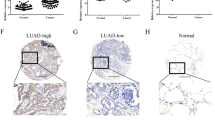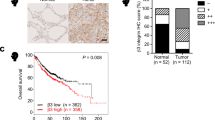Abstract
37-kDa laminin receptor precursor (37LRP) has a crucial role in migration of some human cancers. Epithelial-to-mesenchymal transition (EMT) has received much attention in invasion and metastasis of lung cancer. Nevertheless, the role of 37LRP is not entirely clear in EMT promotion of lung cancer at present. In this study, we firstly examined the possible role of 37LRP in the invasiveness and metastasis process of lung cancer using immunohistochemistry of 80 lung adenocarcinoma cases, western blot and real-time PCR of 12 fresh lung adenocarcinoma tissues. The results showed that 37LRP significantly correlated with clinical stage and were highly expressed in metastatic lung adenocarcinomas compared with nonmetastatic ones. In vitro, we observed that 37LRP significantly increased the adhesive, invasive and metastatic abilities of human lung adenocarcinoma cell lines A549 by 37LRP-lentivirus interference. Furthermore, inoculation of A549 cells transduced with 37LRP-lentivirus in nude mice resulted in multi-metastases including the lung. In addition, western blotting and immunofluorescence were used to detect the significant difference in expression of E-cadherin and fibronectin in A549 by 37LRP-lentivirus interference compared with 37LRP-small interference RNA-lentivirus interference in vitro and vivo. The data indicated that A549 cells of epithelial cell characteristics might be induced to undergo EMT by 37LRP. A549 cells transduced with 37LRP-lentivirus showed marked morphological changes, accompanied by the decrease of epithelial marker E-cadherin and the increase of mesenchymal marker fibronectin. These results indicated that 37LRP may promote lung adenocarcinoma invasion and metastasis via the mechanism of EMT.
This is a preview of subscription content, access via your institution
Access options
Subscribe to this journal
Receive 12 print issues and online access
$259.00 per year
only $21.58 per issue
Buy this article
- Purchase on Springer Link
- Instant access to full article PDF
Prices may be subject to local taxes which are calculated during checkout





Similar content being viewed by others
References
Wahidi MM, Govert JA, Goudar RK, Gould MK, McCrery DC . Evidence for the treatment of patients with pulmonary nodules: when is it lung cancer? ACCP evidence-based clinical practice guidelines (2nd edn. Chest 2007; 132 (3 Suppl): 108S–130S.
Herbst RS, Heymach JV, Lippman SM . Lung cancer. N Engl J Med 2008; 359: 1367–1380.
Jemal A, Siegel R, Ward E, Hao Y, Xu J, Thun MJ . Cancer statistics. CA Cancer J Clin 2009; 59: 225–249.
Hammerschmidt S, Wirtz H . Lung cancer: current diagnosis and treatment. Dtsch Arztebl Int 2009; 106: 809–818.
Terranova VP, Liotta LA, Russo RG, Martin GR . Role of laminin in the attachment and metastasis of murine tumor cells. Cancer Res 1982; 42: 2265–2269.
Wewer UM, Liotta LA, Jaye M, Ricca GA, Drohan WN, Claysmith AP et al. Altered levels of laminin receptor mRNA in various human carcinoma cells that have different abilities to bind laminin. Proc Natl Acad Sci USA 1986; 83: 7137–7141.
Sreenath T, Matrisian LM, Stetler-Stevenson W, Gattoni-Celli S, Pozzatti RO . Expression of matrix metalloproteinase genes in transformed rat cell lines of high and low metastatic potential. Cancer Res 1992; 52: 4942–4947.
Bernhard EJ, Gruber SB, Muschel RJ . Direct evidence linking expression of matrix metalloproteinase 9 (92-kDa gelatinase/collagenase) to the metastatic phenotype in transformed rat embryo cells. Proc Natl Acad Sci USA 1994; 91: 4293–4297.
Gavert N, Ben-Ze'Ev A . Epithelial-mesenchymal transition and the invasive potential of tumors. Trends Mol Med 2008; 14: 199–209.
Zhang HJ, Wang HY, Zhang HT, Su JM, Zhu J, Wang HB et al. Transforming growth factor-beta1 promotes lung adenocarcinoma invasion and metastasis by epithelial-to-mesenchymal transition. Mol Cell Biochem 2011; 355: 309–314.
Romanov VI, Wrathall LS, Simmons TD, Pinto DSP, Sobel ME . Protein synthesis is required for laminin-induced expression of the 67-kDa laminin receptor and its 37-kDa precursor. Biochem Biophys Res Commun 1995; 208: 637–643.
Nelson J, McFerran NV, Pivato G, Chambers E, Doherty C, Steele D et al. The 67 kDa laminin receptor: structure, function and role in disease. Biosci Rep 2008; 28: 33–48.
Givant-Horwitz V, Davidson B, Reich R . Laminin-induced signaling in tumor cells: the role of the M(r) 67,000 laminin receptor. Cancer Res 2004; 64: 3572–3579.
Poon SL, Klausen C, Hammond GL, Leung PC . 37-kDa laminin receptor precursor mediates GnRH-II-induced MMP-2 expression and invasiveness in ovarian cancer cells. Mol Endocrinol 2011; 25: 327–338.
Liu L, Sun L, Zhang H, Li Z, Ning X, Shi Y et al. Hypoxia-mediated up-regulation of MGr1-Ag/37LRP in gastric cancers occurs via hypoxia-inducible-factor 1-dependent mechanism and contributes to drug resistance. Int J Cancer 2009; 124: 1707–1715.
Sun L, Shi Y, Guo C, Yao L, Lin T, Du J et al. Regulation of multidrug resistance by MGr1-antigen in gastric cancer cells. Tumour Biol 2006; 27: 27–35.
Chou TY, Chen WC, Lee AC, Hung SM, Shih NY, Chen MY . Clusterin silencing in human lung adenocarcinoma cells induces a mesenchymal-to-epithelial transition through modulating the ERK/Slug pathway. Cell Signal 2009; 21: 704–711.
Yang J, Liu Y . Dissection of key events in tubular epithelial to myofibroblast transition and its implications in renal interstitial fibrosis. Am J Pathol 2001; 159: 1465–1475.
Ellenrieder V, Hendler SF, Boeck W, Seufferlein T, Menke A, Ruhland C et al. Transforming growth factor beta1 treatment leads to an epithelial-mesenchymal transdifferentiation of pancreatic cancer cells requiring extracellular signal-regulated kinase 2 activation. Cancer Res 2001; 61: 4222–4228.
Gumireddy K, Li A, Gimotty PA, Klein-Szanto AJ, Showe LC, Katsaros D et al. KLF17 is a negative regulator of epithelial-mesenchymal transition and metastasis in breast cancer. Nat Cell Biol 2009; 11: 1297–1304.
Shah PP, Fong MY, Kakar SS . PTTG induces EMT through integrin alphaVbeta3-focal adhesion kinase signaling in lung cancer cells. Oncogene 2012; 31: 3124–3135.
Wang Y, Li Z, Zhang H, Jin H, Sun L, Dong H et al. HIF-1alpha and HIF-2alpha correlate with migration and invasion in gastric cancer. Cancer Biol Ther 2010; 10: 376–382.
Ito M, Tanaka S, Kim S, Kuwai T, Matsutani N, Kamada T et al. The specific expression of hypoxia inducible factor-1alpha in human gastric mucosa induced by nonsteroidal anti-inflammatory drugs. Aliment Pharmacol Ther 2003; 1: 90–98.
Lois C, Hong EJ, Pease S, Brown EJ, Baltimore D . Germline transmission and tissue-specific expression of transgenes delivered by lentiviral vectors. Science 2002; 295: 868–872.
Rao CN, Castronovo V, Schmitt MC, Wewer UM, Claysmith AP et al. Evidence for a precursor of the high-affinity metastasis-associated murine laminin receptor. Biochemistry 1989; 28: 7476–7486.
Liu L, Sun L, Zhao P, Yao L, Jin H, Liang S et al. Hypoxia promotes metastasis in human gastric cancer by up-regulating the 67-kDa laminin receptor. Cancer Sci 2010; 101: 1653–1660.
Fatehullah A, Doherty C, Pivato G, Allen G, Devine L, Nelson J et al. Interactions of the 67 kDa laminin receptor and its precursor with laminin. Biosci Rep 2009; 30: 73–79.
Patarroyo M, Tryggvason K, Virtanen I . Laminin isoforms in tumor invasion, angiogenesis and metastasis. Semin Cancer Biol 2002; 12: 197–207.
Engbring JA, Kleinman HK . The basement membrane matrix in malignancy. J Pathol 2003; 200: 465–470.
Ekblom P, Lonai P, Talts JF . Expression and biological role of laminin-1. Matrix Biol 2003; 22: 35–47.
Kasai H, Allen JT, Mason RM, Kamimura T, Zhang Z . TGF-beta1 induces human alveolar epithelial to mesenchymal cell transition (EMT). Respir Res 2005; 6: 56–64.
Shintani Y, Maeda M, Chaika N, Johnson KR, Wheelock MJ . Collagen I promotes epithelial-to-mesenchymal transition in lung cancer cells via transforming growth factor-beta signaling. Am J Respir Cell Mol Biol 2008; 38: 95–104.
Morais FV, Nogueira DGDS, Cyreno OE, Furuse C, Cavalcanti DAV et al. Malignancy-related 67kDa laminin receptor in adenoid cystic carcinoma. Effect on migration and beta-catenin expression. Oral Oncol 2007; 43: 987–998.
Heldin CH, Landstrom M, Moustakas A . Mechanism of TGF-beta signaling to growth arrest, apoptosis, and epithelial-mesenchymal transition. Curr Opin Cell Biol 2009; 21: 166–176.
Miettinen PJ, Ebner R, Lopez AR, Derynck R . TGF-beta induced transdifferentiation of mammary epithelial cells to mesenchymal cells: involvement of type I receptors. J Cell Biol 1994; 127: 2021–2036.
Acknowledgements
Tissue collection was supported by the Department of Pathology and General Surgery of Xijing Hospital in Xi’an, China. This work was supported by the National Nature Science Foundation of China (grant numbers: 30971338, 81101765 and 30901752).
Author information
Authors and Affiliations
Corresponding authors
Ethics declarations
Competing interests
The authors declare no conflict of interest.
Rights and permissions
About this article
Cite this article
Wang, Y., Dong, H., Xu, M. et al. 37-kDa laminin receptor precursor promotes lung adenocarcinoma cell invasion and metastasis by epithelial-to-mesenchymal transition. Cancer Gene Ther 21, 150–157 (2014). https://doi.org/10.1038/cgt.2014.10
Received:
Revised:
Accepted:
Published:
Issue Date:
DOI: https://doi.org/10.1038/cgt.2014.10



